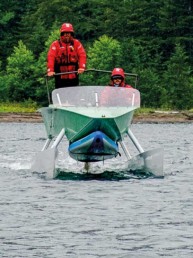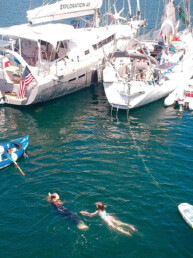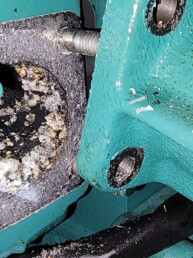We recently got a stark reminder from the United States Coast Guard that it’s time to start thinking about preparing our boats and crew for colder weather and rougher seas. If you’re planning to head out on the water this winter (which we enjoy) here are their recommendations.
- Wear Your Life Jacket: A life jacket only works if you’re wearing it. Accidents happen quickly, and in cold water, every second counts. Ensure your life jacket fits properly, regardless of your age or swimming ability.
- Dress for the Water, Not the Weather: Water temperatures can be dangerously low, even on sunny days. Dress in layers, wear a properly fitted life jacket over your coat, and bring extra clothing in case you get wet.
- Maintain Awareness: Recognize sea conditions can change rapidly throughout the Day, especially when winds pick up and tides change
- Plan Ahead for Shorter Days: Darkness falls earlier in colder months. Plan your trip to make the most of available daylight and ensure a safe return.
- Double Up on Communication: Cell phones alone may not provide sufficient communication on the water. Bring at least two reliable forms of communication, such as a VHF radio and a personal locator beacon and inform someone of your float plan. Having the right safety gear can make the difference between being lost and being found.
- Have a Working GPS or Nautical Charts That Mark Hazards: It’s important to be aware of your surroundings and have knowledge of the local boating area and conditions.
- Check the Forecast: Visit weather.gov or ndbc.noaa.gov for up-to-date weather and marine forecasts before heading out.
And if you’re planning to shut down your boat for the season, here’s a checklist written by longtime 48° North contributor, professional sailing instructor, and owner of San Juan Sailing, Mike Huston, published in 48° North back in 2009. It still rings true today!
Winter is on its way and it is time to get our boats ready to withstand the hardships that come with it. Make sure you’ve thought about what how to take care of your boat as we enter a new season.
Winter hardships come in several forms:
Cold: Freezing conditions can split water pipes or tanks.
Mildew: Loves the moist conditions caused by condensation and rains.
Strong Winds: Can chafe dock lines, damage canvas or literally shred sails.
Snow: Can get heavy enough to tear canvas dodgers, etc.
This is not a complete list but hopefully you get the flavor. So, what can we do to help our boats get through the winter unscathed? The following are some ideas that might be helpful, they are broken into two groups — the first list covers things to do on all boats, and the second list discusses additional ideas for boats likely to sit unused all winter.
For All Boats
Fuel System
Fill the fuel tanks all the way full. This will prevent condensation from adding water to the tanks. Also, add a biocide and stabilizer before topping them off to prevent algae growth and/or separation.
Water System
Empty tanks and lines that might be exposed to freezing temperatures. Lines running along the side of the hull are the most susceptible.
Heat
Keep the inside of the boat warmer than outside and above freezing, usually by running an electrical heater or two inside the boat. Heaters that have fans are best because they keep air circulating. Also, open all the lockers, drawers, lift floor boards, etc.; the goal is to allow good airflow to all parts of the boat. These actions will help prevent mildew and freezing.
Mooring System
Double up dock lines and add chafe gear at the rub points.
Running Rigging
Be sure furling lines and sheets are really secure, many a jib has been shredded when the furling line came loose allowing them to deploy during a storm. Also, for the sanity of your neighbors, be sure halyards, etc. are pulled away from the mast to prevent slapping. One other small tip: if you have lines that are out in the open, such as jib sheets, coil them and hang them off the deck; this keeps them from growing green stuff.
Exterior Teak or Exposed Wood
If your wood is finished, apply a couple coats to bare spots. Even if your plan is to refinish in the spring this will help seal and protect the wood during the winter.
Close Through-hulls
Close all the through-hulls. This one is just a good safety practice. However, if you close the engine or generator cooling intakes be sure to post or tape a note on the controls so they cannot be started in that state.
Winter Watch
Check on the boat frequently, mostly to be sure the heaters are still working. This is especially important when the outside temperature drops below freezing for several days. Also, if it snows heavily be sure to remove the snow from areas covered by canvas (dodgers, biminis, etc.) before the rains come and add weight.
General Equipment
- If you do not have a canvas cover, use some plastic to cover the binnacle and/or instruments. I use a large garbage bag and duct tape to cover ours.
- Take equipment that can be removed, for example LifeSlings, barbecues, outboards, etc., and store them out of the weather.
- Top off the water in wet-cell batteries.
- Drain toilets or add bio-degradable anti-freeze to them.
- Empty holding tanks.
- Clean hatch and port seals, then lubricate with silicone grease.
- Apply a coat of wax to the topside – this makes clean-up in the spring easier. This is something I try to do during our last couple trips out on the boat in late summer or fall. Okay, I admit I like to putter on the boat and this is the perfect putter job.
For Boats Not Likely to be Used Over the Winter
Remove the Sails
Take the sails off and store them at home or below decks. It is also a good idea to take them to a sailmaker for a check-up.
Remove the Dodger and Bimini
The canvas will last a lot longer if it does not sit out all winter. Be sure to store with no folds in the glass.
Remove Running Rigging
Take off and store below all running rigging not being used. This keeps the lines clean and extends their life. Consider running messenger lines in their place for easier rigging in the spring.
I am sure there are other things I have forgotten but this should cover the basics. Your boat may have some other gear needing special attention, for example watermakers may need to be pickled.
This may look like a long list but my wife and I can do most of this in one weekend. We find these basics go a long way toward keeping our boat safe and reduce the work and expense needed to get ready for sailing come spring.
Title background image courtesy of Noreen Light.
Editor
48° North Editors are committed to telling the best stories from the world of Pacific Northwest boating. We live and breathe this stuff, and share your passion for the boat life. Feel free to keep in touch with tips, stories, photos, and feedback at news@48north.com.






